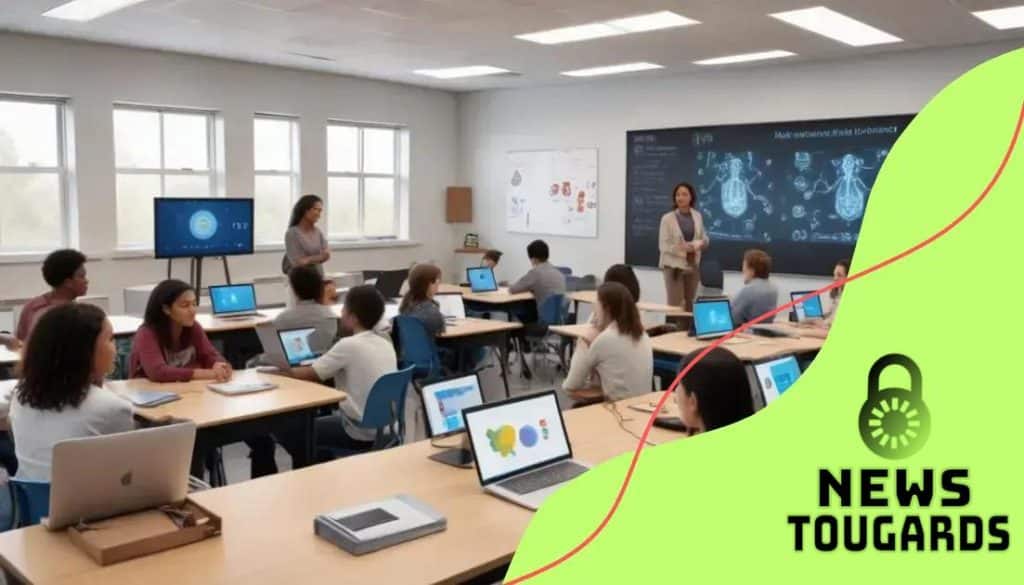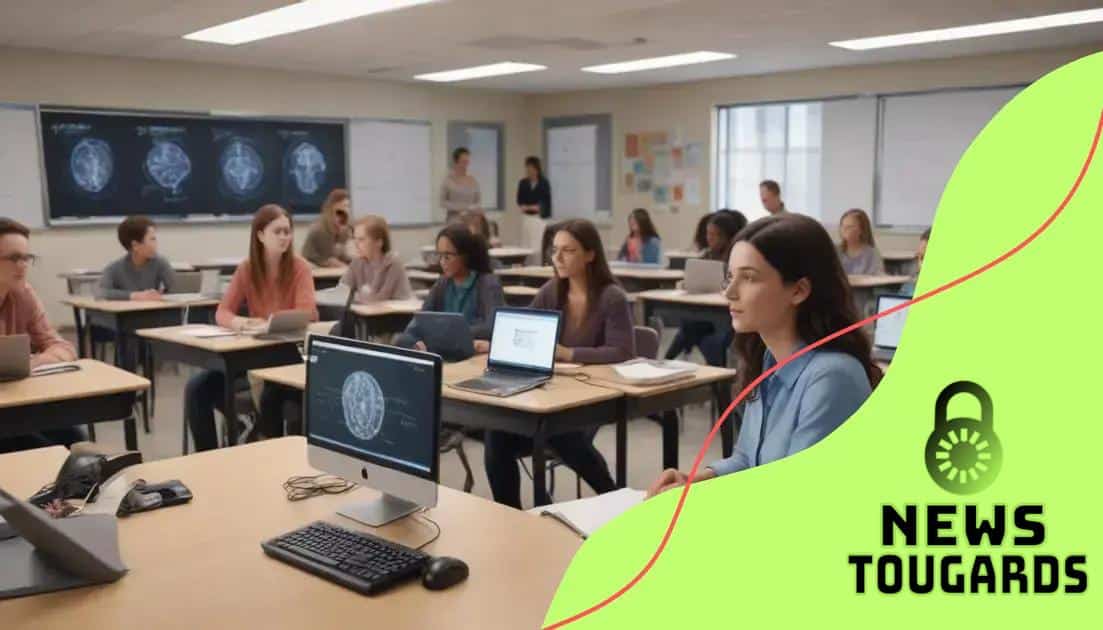AI literacy in schools: why it matters now

AI literacy in schools is no longer optional, it’s essential. As technology rapidly advances, equipping students with the ability to understand and work with artificial intelligence is key to preparing them for the future.
From enhancing critical thinking and digital skills to enabling personalized learning and streamlining school operations, AI literacy empowers students to thrive in a tech-driven world.
But what does this really mean in practice? Let’s explore how AI is reshaping education and opening doors to new opportunities for the next generation.
Understanding AI literacy
Understanding AI literacy is essential in today’s technology-driven world. It empowers students with the foundational knowledge and critical skills they need to navigate a future increasingly influenced by artificial intelligence.
This journey begins with understanding the basics, what AI is, how it works, and where we encounter it in daily life, and gradually progresses to more complex ideas, such as ethical considerations, data analysis, and responsible use.
By developing AI literacy, students are better prepared to think critically, adapt to innovation, and actively participate in shaping the digital future.
What is AI literacy?
AI literacy involves much more than simply knowing how to use AI tools. It’s about understanding how artificial intelligence functions, how it’s developed, and the broader impact it has on individuals and society.
This includes grasping the role of data in training AI systems, the algorithms that guide its decision-making processes, and how these technologies influence everything from social media feeds to healthcare and job markets.
Developing this awareness helps students become not just users, but informed and responsible participants in an AI-driven world.
The importance of teaching AI literacy
Teaching AI literacy helps prepare students for future careers. Here are some reasons why it is crucial:
- It fosters critical thinking skills.
- Students learn to evaluate and interpret AI outputs.
- They become informed consumers of technology.
By learning these skills, students can become active participants in a world where AI plays a significant role.
Moreover, early exposure increases their comfort level with technology, setting a foundation for advanced study.
Key concepts in AI literacy
Some fundamental concepts include understanding machine learning, data privacy, and ethical implications of AI. These topics help students grasp how AI technologies function and why they matter.
Moreover, discussing the ethical aspects encourages students to think about the responsibilities that come with using AI tools.
What should they consider before adopting such technologies? How do these tools impact privacy and security?
By engaging with these questions, students build a more profound understanding of the role of AI in society.
This comprehensive understanding aids them in navigating the challenges and opportunities of an AI-driven future.
The impact of AI in education
The impact of AI in education is both profound and far-reaching. It’s reshaping how students learn, how teachers teach, and how schools operate behind the scenes.
By integrating AI tools into the classroom, educators can design personalized learning pathways that adapt to each student’s strengths, weaknesses, and learning styles.
This not only enhances engagement and comprehension but also allows teachers to focus more on meaningful interactions and less on repetitive tasks.
As a result, AI is paving the way for a more efficient, inclusive, and student-centered education system.
Transforming teaching methods
One of the most significant advancements brought by AI is the way teachers deliver lessons. With the help of intelligent tools, educators can create dynamic, interactive content that captures students’ attention and enhances understanding.
AI-powered platforms also enable real-time assessment of student performance, providing immediate insights into progress and areas that need improvement.
This timely feedback is essential for supporting personalized learning and fostering continuous academic growth.
Through these innovations, AI is helping teachers become more effective and responsive in the classroom.
Enhancing learning experiences
AI enhances learning by adapting to each student’s pace. For example, educational applications can analyze a student’s strengths and weaknesses.
Based on this data, they adjust the difficulty of tasks. This kind of support helps students grasp concepts without feeling overwhelmed.
- Students receive feedback instantly.
- Lessons become more tailored to individual needs.
- Engagement rises with interactive learning.
The rise of virtual tutors powered by AI also opens new avenues for support. These tutors offer students additional help outside classroom hours. As a result, more learners can access the resources they need to succeed.
Streamlining administrative tasks
Admins in schools face various challenges, but AI also helps here. It automates repetitive tasks like grading and attendance tracking, freeing up valuable time for teachers.
They can then focus more on teaching and interacting with students, rather than getting bogged down by paperwork.
With AI tools, schools can analyze data trends to improve their operations.
By understanding which programs work, administrators can make informed decisions about resource allocation and curriculum adjustments. This data-driven approach enhances the overall educational environment.
Integrating AI into the curriculum

Integrating AI into the curriculum is a vital step in modern education. It goes beyond simply enhancing classroom learning, it equips students with the skills and mindset needed to thrive in a future where technology is deeply embedded in every industry.
By incorporating AI tools, educators can design dynamic and engaging lessons that reflect real-world challenges and opportunities.
This not only makes learning more relevant and interactive but also fosters critical thinking, adaptability, and digital fluency, all essential for success in the 21st-century workforce.
Curriculum design with AI
When designing the curriculum, teachers can seamlessly embed AI components into existing subjects to enhance relevance and engagement.
For instance, mathematics lessons can incorporate AI-driven problem-solving techniques or explore how algorithms are used in data analysis and machine learning.
By integrating these elements, students not only grasp core academic concepts but also gain insight into their real-world applications.
This approach bridges the gap between theory and practice, helping learners understand the practical value of what they’re studying while building essential future-ready skills.
Collaborative learning environments
AI fosters collaboration among students. With online platforms, learners can work together on projects, using AI tools to gather information or analyze data. This collaboration not only enhances their understanding but also builds teamwork skills.
- Students learn to value diverse perspectives.
- They develop critical thinking through group discussions.
- Tactics for problem-solving improve with shared insights.
Furthermore, AI can assist teachers in identifying students’ strengths and weaknesses. This data-driven approach enables tailored lesson plans that cater to the needs of each learner.
Professional development for educators
For successful integration, it’s crucial that educators themselves understand AI. Professional development programs focusing on AI literacy for teachers provide them with the skills needed to implement these technologies effectively.
Training sessions can focus on how to use AI tools in lesson planning and student assessment.
As educators become more comfortable with AI, they can better guide students through navigating these systems.
This ensures that students not only use AI but also understand its implications, fostering a sense of responsibility in technology usage.
Skills students gain from AI exposure
The skills students gain through exposure to AI are essential for thriving in today’s rapidly evolving world.
As they interact with AI tools, they develop a wide range of competencies, from critical thinking and problem-solving to data literacy and ethical reasoning.
These abilities not only prepare them to navigate future academic and career challenges but also empower them to become informed, responsible digital citizens.
Recognizing and nurturing these skills allows educators and students alike to fully appreciate the transformative role of AI in modern education.
Critical thinking and problem-solving
Engaging with AI encourages students to think more critically and independently. When they use AI-driven tools to analyze data or solve problems, they’re prompted to ask deeper, more meaningful questions.
This process helps them evaluate information with a discerning eye, identify patterns, and draw conclusions based on evidence rather than assumption.
Over time, these experiences foster analytical thinking, a skill that’s essential not only in academics but also in navigating everyday decisions in a data-driven world.
Digital literacy
AI integrates technology into learning, enhancing digital literacy.
Students become familiar with various platforms and tools, which builds their confidence in using technology. With this knowledge, they can navigate digital environments effectively.
- Understanding algorithms
- Using AI for research
- Interpreting data outputs
This proficiency in technology not only aids them in academic settings but also significantly boosts their employability in the future.
Collaboration and communication
Working with AI tools often involves collaboration. Students frequently team up to complete projects, sharing insights and resources.
This cooperation reinforces essential communication skills. They learn to express their thoughts clearly and listen to others, fostering an inclusive learning environment.
Moreover, as they use AI together, students learn to respect different perspectives. This experience is valuable as they enter diverse workplaces, helping them to work effectively with others.
Adaptability and resilience
AI changes rapidly, and students must adapt to these ongoing developments. This constant evolution teaches them resilience.
They learn that setbacks are part of the learning process and that flexibility is crucial when faced with new challenges.
Additionally, experimentation with AI tools encourages a growth mindset. Students understand that mistakes are opportunities for learning, pushing them to embrace new ideas and concepts actively.
Challenges in teaching AI literacy
Teaching AI literacy presents a range of challenges that educators must thoughtfully navigate.
With technology evolving at a rapid pace, integrating AI concepts and tools into the classroom can feel overwhelming, especially for teachers who may lack technical backgrounds or adequate training.
Recognizing these obstacles is the first step toward building effective strategies.
From addressing resource gaps to ensuring equitable access and staying updated on emerging trends, educators can better prepare themselves to introduce AI in a meaningful and inclusive way.
Resource availability
One significant challenge is the limited availability of resources. Many schools, especially in underfunded areas, may not have the budget to implement advanced AI tools or support infrastructure.
This lack of access makes it difficult for educators to introduce AI concepts in a practical and engaging way.
In addition, even when the technology is available, there is often a shortage of adequate training for teachers.
Without proper professional development, educators may struggle to use AI tools confidently or integrate them effectively into their lessons, further widening the digital and educational gap.
Keeping up with rapid advancements
Another hurdle is the fast pace of AI development. New tools, applications, and methodologies emerge regularly, making it hard for teachers to stay current.
They need ongoing professional development to keep pace with changes. This constant learning can be overwhelming and time-consuming.
- Distinguishing effective AI tools from less useful ones.
- Integrating new tools into existing curricula.
- Adapting to evolving ethical guidelines in AI.
As a result, teachers may struggle to deliver relevant and engaging lessons, which can impact student understanding and interest.
Student readiness
Not all students may come into the classroom with the same level of familiarity with technology. Some might find it challenging to grasp AI concepts due to varying baseline skills.
This gap can create disparities in learning, where more tech-savvy students outpace those who need additional support.
Furthermore, understanding the ethical implications of AI is essential but can be complex.
Students might not fully grasp how AI impacts their lives, leading to questions and confusion around privacy, data usage, and job displacement.
Future prospects for AI in schools

The future prospects for AI in schools are both promising and transformative. As technology advances, schools are likely to adopt AI tools more widely to enhance teaching and learning.
This shift can personalize education for students and provide teachers with valuable tools to support instruction and monitor progress.
With thoughtful integration, AI has the power to redefine what’s possible in the classroom.
It can enable truly personalized learning experiences, enhance teacher effectiveness, and foster more inclusive, engaging, and future-ready educational environments.
Personalized learning experiences
One key prospect for the future of AI in education is the expansion of personalized learning.
By analyzing each student’s performance, learning pace, and preferences, AI can help educators adapt their teaching methods to meet individual needs more precisely.
This level of customization makes lessons more engaging and impactful, as they align with the way each student learns best, ultimately improving both understanding and long-term academic outcomes.
Enhanced administrative efficiency
AI can also streamline administrative tasks in schools. By automating functions like enrollment, scheduling, and grading, educators can focus more on teaching.
This efficiency not only saves time but also enables staff to better support students. The goal is to create a more productive environment where everyone benefits.
- Reduced administrative burdens on teachers.
- Enhanced data analytics for informed decision-making.
- Improved communication between staff, students, and parents.
As schools embrace these changes, they will likely see an improvement in collaboration and resource sharing among educators.
Developing a tech-savvy workforce
Preparing students for the workforce of the future is another vital prospect. With AI becoming integrated into many industries, schools that implement these technologies will better equip students with the skills they need.
Knowledge of AI tools and applications will be a significant asset in various career paths.
Moreover, schools can emphasize the ethical use of AI. Teaching students about responsible technology use will ensure they understand the implications of AI in society.
This awareness builds informed citizens who can navigate and shape the future responsibly.
FAQ – Frequently Asked Questions about AI Literacy in Schools
What is AI literacy?
AI literacy is the understanding of artificial intelligence’s concepts, tools, and ethical implications in our daily lives and careers.
How can AI enhance learning in schools?
AI can create personalized learning experiences by analyzing student performance and adapting lessons to fit individual needs.
What challenges do schools face in teaching AI?
Schools often struggle with resource availability, teacher training, and keeping up with the rapid advancements in AI technology.
What skills do students gain from AI exposure?
Students develop critical thinking, digital literacy, collaboration, and adaptability skills that are essential for future success.





